
PREV ARTICLE
NEXT ARTICLE
FULL ISSUE
PREV FULL ISSUE
MANKATO DAKOTA INDIANS HANGING ITEMS
I get schooled every day while working on The E-Sylum. And each day is a surprise, because I rarely know what topics will pop up or which article will generate response. This week's hot topic is Matt Hansen's question about numismatic representations of the mass execution of 38 Dakota Indians by hanging on December 26, 1862, at Mankato, Minnesota.
-Editor
Pete Smith writes: I grew up in New Ulm, Minnesota, about thirty miles upriver from Mankato. In August of 1862 the town was attacked twice by Indians. In early years this was called the Indian Massacre of 1862. Local militias repelled both attacks but the town was later evacuated to Mankato. I graduated from high school in 1962, the year of the centennial commemoration of the event, then known as the Sioux Uprising of 1862. I participated in various events related to the centennial. I then went to college in Mankato. I was very familiar with the site of the hanging. At one time a local museum had one of the timbers from the scaffolding used to hang the 38 Indians. I heard later that the timber had gone missing.. Another fifty years have passed and the event is now known as the Dakota Conflict of 1862, unless I have missed another politically correct change of name. I certainly would have paid attention to a medal depicting the hanging, but I can't recall seeing one. There are a number of badges and medals related to the events in New Ulm. I have looked through the collection of such medals at the Brown County Historical Society. They do not appear on the market frequently and are expensive when offered. There is a beer tray depicting the hanging in 1862 and some print items. Again they are actively collected. I haven't visited the Blue Earth County Museum since I graduated from college. They might have some items related to the hanging. I can assume that if I haven't seen such medals, they are probably quite rare.
Alan found this image of the beer tray he mentioned.
-Editor
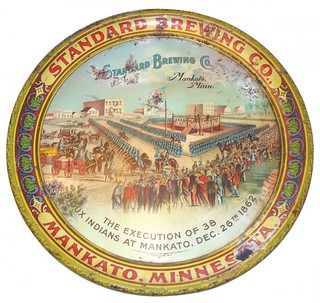
Jerry Adams of Keller, Texas writes: I was aware of the numismatic representation of the hanging of the 38 Sioux, and have held one of those medals in my hand and examined it first-hand. They are evidently pretty rare as it is the only one I have ever seen "in hand". The one I saw and handled was at the National Token Collectors Association annual token show in Fargo, N.D. in September 2010. Since the medal was issued in 1899 and the hanging was in 1862, some 37 years later, Mankato memorialized its history, just as Gettysburg or Chickamuga. History is often written with blood.
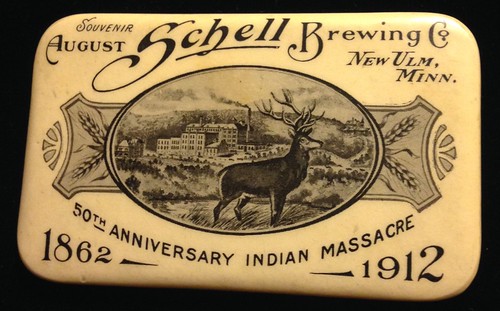
Alan V. Weinberg writes: There are a number of rare 1862 Lakota Massacre Hanging advertising items known. One is this very rare brewery advertising mirror in my collection. There is also a large very colorful tin serving tray depicting the mass hanging of the 38 Lakotas. Seems the circa 1900 advertising crowd thought this Civil War era mass hanging was worth celebrating in Minnesota history.
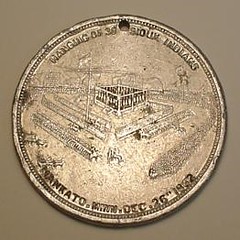
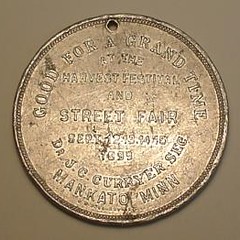
Kay Olson Freeman writes: The token was made by Whitehead & Hoag Co., Newark, NJ. (marked “W. & H. Co. Newark, NJ” on reverse, under “Mankota, Minn”). The partnership of Benjamin Whitehead and Chester Hoag started in 1892. The scene of the hangings was first shown contemporaneously in Frank Leslie’s Illustrated News in January 1863. W.H. Childs did the sketch for the lithograph. This is the source for all depictions of the hangings. I do not know who “W.H. Childs” was. I first learned of the 1862 hangings through an article “A Souvenir Spoon with a Horrific Story” by Robert Wilhelm in the March/April 2006, SILVER magazine, p. 14. Wilhelm’s article illustrated the scene (engraved finely) in the bowl of a silver souvenir spoon manufactured by Watson & Newell Co., Attleboro, MA. The handle of that spoon was in the “Poppy” pattern @ 1902-1904. A different souvenir spoon, called the “Mankota Spoon,” with the same hanging scene engraved (rather crudely) in the bowl, was discussed in 2008 on the PBS TV show “History Detectives.” That souvenir spoon was then thought to be dated @ 1902. No maker of the spoon was mentioned. Its handle design pattern differed from the Watson & Newell – not floral but baroque curves. The TV show (segment can be read online) explained why souvenirs, such as Matt Hansen's token, would be made in the late 19th C. – early 20th C. about an event that occurred much earlier.
To read the earlier E-Sylum article, see:
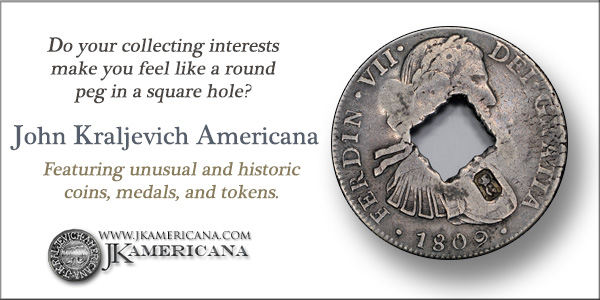
Wayne Homren, Editor The Numismatic Bibliomania Society is a non-profit organization promoting numismatic literature. See our web site at coinbooks.org. To submit items for publication in The E-Sylum, write to the Editor at this address: whomren@gmail.com To subscribe go to: https://my.binhost.com/lists/listinfo/esylum All Rights Reserved. NBS Home Page Contact the NBS webmaster 
|